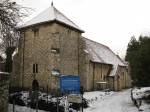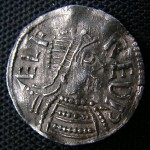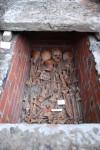 Last year, in the wake of the announcement that the remains of King Richard III had been discovered, the church authorities granted archaeologists permission to exhume an unmarked grave reputed to hold the bones of King Alfred the Great in the cemetery of St. Bartholomew’s Church in Winchester. To exactly no one’s surprise, they did not find the bones of Alfred the Great.
Last year, in the wake of the announcement that the remains of King Richard III had been discovered, the church authorities granted archaeologists permission to exhume an unmarked grave reputed to hold the bones of King Alfred the Great in the cemetery of St. Bartholomew’s Church in Winchester. To exactly no one’s surprise, they did not find the bones of Alfred the Great.
Alfred’s bones were moved several times after his first burial in Winchester’s Old Minster in 899. In 1110, the remains of Alfred, his wife Ealhswith, his son and successor Edward the Elder and Edward’s children were moved to Hyde Abbey. The Abbey was destroyed by Henry VIII’s marauders during the dissolution of the monasteries but reportedly the human remains interred there weren’t damaged. Construction of a prison on the site in 1788, on the other hand, appears to have been a riot of damage. A Catholic bishop named John Milner wrote about the destruction:
Miscreants couch amidst the ashes of our Alfreds and Edwards; and where once religious silence and contemplation were only interrupted by the bell of regular observance, and the chanting of devotion, now alone resound the clank of the captive’s chains and the oaths of the profligate! In digging for the foundations of that mournful edifice [the prison] at almost every stroke of the mattock or spade some ancient sepulchre was violated, the venerable contents of which were treated with marked indignity, A great number of stone coffins were dug up, with a variety of curious articles, such as chalices, patens, rings, buckles, the leather of shoes and boots, velvet and gold belonging to chasubles and other vestments as also the crook, rims and joints of a beautiful crozier, double gilt.
According to Captain Henry Howard who heard it from the foreman of the construction site 10 years after the events,
A great stone coffin was found, cased with lead both within and without, and containing some bones and remains of garnets. The lead, in its decayed state, sold for two guineas; the bones were thrown about and the stone coffin broken into pieces. There were also two other coffins and no more found in this part, which were also broke for the sake of the garden in which they lay, broken up and buried as low as the spring.
 The stone coffins and expensive artifacts suggested these brutes may have desecrated royal graves, and for nothing because the prison didn’t even last 50 years. It was demolished in 1840. When antiquarian John Mellor excavated the Hyde Abbey site in 1866, he claimed to have found the Wessex dynasty tombs and identified one of five skulls he had unearthed as that of Alfred the Great based on a visual comparison with Alfred’s face on a coin. Yeah, he was a … creative fellow. He created several other entertaining tale tales about discoveries he purportedly made and also salted the site with supposedly 10th century artifacts. After the dig, Mellor gave the bones he had unearthed to the rector of Saint Bartholomew’s Church who buried them in an unmarked grave in the churchyard.
The stone coffins and expensive artifacts suggested these brutes may have desecrated royal graves, and for nothing because the prison didn’t even last 50 years. It was demolished in 1840. When antiquarian John Mellor excavated the Hyde Abbey site in 1866, he claimed to have found the Wessex dynasty tombs and identified one of five skulls he had unearthed as that of Alfred the Great based on a visual comparison with Alfred’s face on a coin. Yeah, he was a … creative fellow. He created several other entertaining tale tales about discoveries he purportedly made and also salted the site with supposedly 10th century artifacts. After the dig, Mellor gave the bones he had unearthed to the rector of Saint Bartholomew’s Church who buried them in an unmarked grave in the churchyard.
 When University of Winchester archaeologists opened the grave, they found the skeletons of at least six people, including five skulls. After a few months, the Diocese granted them permission to clean and test the bones. Radiocarbon dating proved that these could not be the bones of Alfred and his immediate family. Alfred reigned from 871 – 899; his son Edward the Elder died in 924; Edward’s son Athelstan died childless in 939 and his other son Edmund I died in 946. The oldest of the bones from the unmarked grave dated to 1100. The rest dated from 1230 to 1500 and showed extensive signs of degenerative health conditions which suggests they may have been patients who died in the Hyde Abbey infirmary.
When University of Winchester archaeologists opened the grave, they found the skeletons of at least six people, including five skulls. After a few months, the Diocese granted them permission to clean and test the bones. Radiocarbon dating proved that these could not be the bones of Alfred and his immediate family. Alfred reigned from 871 – 899; his son Edward the Elder died in 924; Edward’s son Athelstan died childless in 939 and his other son Edmund I died in 946. The oldest of the bones from the unmarked grave dated to 1100. The rest dated from 1230 to 1500 and showed extensive signs of degenerative health conditions which suggests they may have been patients who died in the Hyde Abbey infirmary.
All hope was not lost, however. In 1999, an excavation of the abbey site done by the Winchester City Museum had recovered some bones. These were stored in two boxes at the museum but had never been thoroughly analysed due to lack of funds. After the St. Bartholomew’s Church bones were found to be too recent, Winchester University’s Dr. Katie Tucker, team leader of the exhumation project, was notified of the Winchester City Museum bones and arranged to have them tested. A piece of pelvic bone, recorded as having been found in a pit in front of the monastery’s High Altar, was radiocarbon dated to between 895 and 1017. Osteological analysis identified the bone as having probably belonged to an adult male who was between 26 and 45 at the time of death.
 This is the only bone ever found to date to the era when Alfred and his family were interred. Its find spot in front the High Altar is also an important piece of the puzzle because only the royal family was buried there. This could indeed be a small piece of either King Alfred or King Edward.
This is the only bone ever found to date to the era when Alfred and his family were interred. Its find spot in front the High Altar is also an important piece of the puzzle because only the royal family was buried there. This could indeed be a small piece of either King Alfred or King Edward.
Or not. The problem is the chances of actually identifying a third of a pelvic bone as belonging to a king who died 1100 years ago are infinitesimally small. With the Richard III discovery, they found a fully articulated skeleton in its original context. There was a wealth of circumstantial evidence derived from the bones — battle wounds, scoliosis — and they were able to extract DNA for comparison to modern descendants of Richard’s sister. One chunk of pelvis really can’t tell us much about its owner, and recovering historical DNA is already a great challenge even when the bones haven’t been moved and exposed to God knows what conditions multiple times over the centuries.
Even if they did catch the luckiest of breaks and were able to extract DNA from the bone, finding someone to compare it to for identification would be a whole other snipe hunt. A modern descendant, if there even are any, could take years to locate. DNA from Alfred’s granddaughter Queen Eadgyth (her remains were found in the Cathedral of Magdeburg in Germany in 2008) would have done the trick, but her bones were too damaged to extract a viable DNA sample.
They’ll give it the old college try, though. Meanwhile, the renewed interest in Alfred’s remains has renewed interest in the Hyde Abbey site. The University of Winchester team is hoping to parlay that into a new excavation.
BBC cameras have followed the team on their journey. The Search for Alfred the Great debuts on BBC2 on Tuesday, January 21st. They’ve released some clips from the show already, and by some miracle they are both embeddable and viewable outside the UK, so here you go.